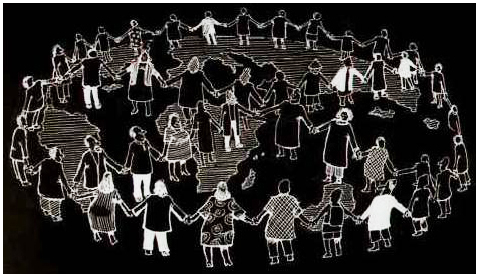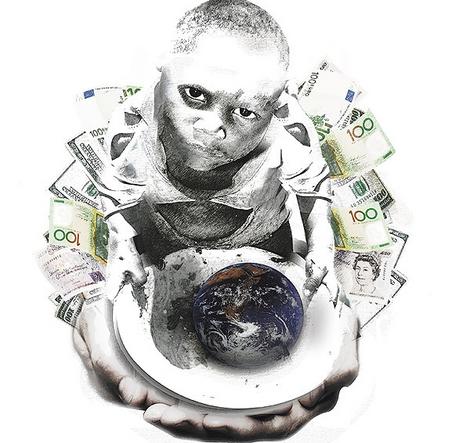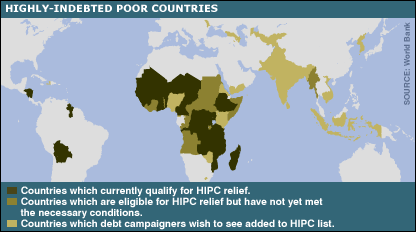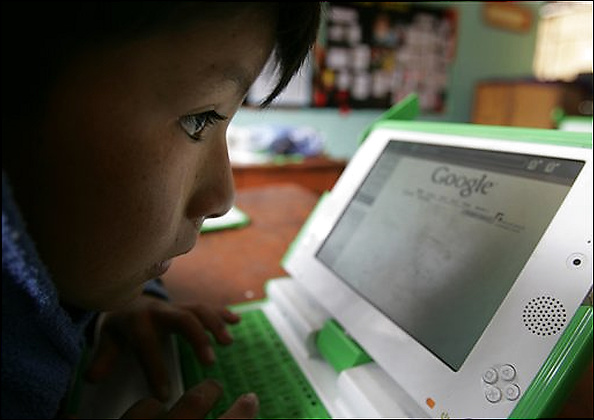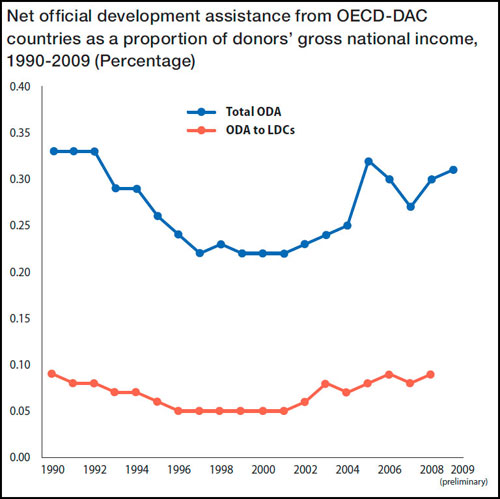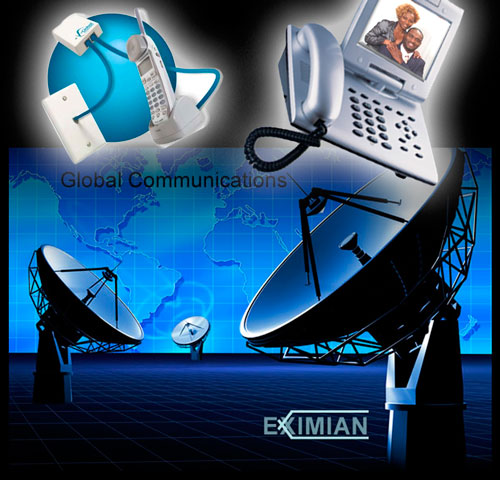DeAnza College/CIS2/Summer 2010/Group 6
| Students @ Work - a student collaborative writing project. Help us by providing feedback on the Discussion page. |
The United Nations' Millenium Development Goals: Global Partnership
In 2000, the United Nations vowed that "We will spare no effort to free our men, women and children from the abject and dehumanizing conditions of extreme poverty, to which more than a billion of them are currently subjected. We are committed to making the right to development a reality for everyone and to freeing the entire human race from want".[1]
In accordance with this mission, the United Nations developed the Millenium Development Goals to liberate the globe of abject poverty. The eighth goal of this platform, Global Partnership, was intended to establish an international network of rich nations to help poverty-ridden nations increase development. According to the United Nations, "the deal makes clear that it is the primary responsibility of poor countries to work towards the first Seven Goals. They must do their part to ensure greater accountability to citizens and efficient use of resources. But for poor countries to achieve the first seven Goals, it is absolutely critical that rich countries deliver on their end of the bargain with more and more effective aid, more sustainable debt relief and fairer trade rules, well in advance of 2015".[2]
Contents
- 1 Global PartnershipThe United Nations' Millenium Development Goals: Global Partnership
- 2 2015 Global Partnership Targets
- 3 Global Trading and Financial System
- 4 Debt Sustainability
- 5 Access to new technologies for global citizens
- 6 Global poverty reduction
- 7 Global communications/connections & education
- 8 Essential and Affordable drugs for Global Citizens
- 9 References
2015 Global Partnership Targets
The 2015 Global Partnership has six major targets.[3]
- Develop further an open, rule-based, non-discriminatory trading and financial system - Includes a commitment to good governance, development and poverty reduction - both nationally and internationally.
- Address the special needs of the least developed countries - Includes: tariff and quota free access for the least developed countries' exports; enhance programme of debt relief for heavily indebted poor countries (HIPC) and cancellation of official bilateral debt; and more generous ODA for countries committed to poverty reduction.
- Address the special needs of landlocked developing countries and small island developing States (through the Programme of Action for the Sustainable Development of Small Island Developing States and the outcome of the twenty-second special session of the General Assembly.)
- Deal comprehensively with the debt programs of developing countries through national and international measures in order to make debt sustainable in the long term
- In cooperation with pharmaceutical companies, provide access to affordable essential drugs in developing countries.
- In cooperation with private sector, make available the benefits of new technologies, especially information and communications.
Measuring the Global Partnership Targets
In order to measure the success of the program, quantifying milestones is important to gauge the improvements in "the least developed countries (LDCs), Africa, and landlocked developing countries and small island States".[4]
1. Official Development Assistance
- Net ODA, total and to the least developed countries, as percentage of OECD/DAC donors; gross national income
- Proportional of total bilateral, sector-allocable ODA of OECD/DAC donors to basic social services (basic education, primary health care, nutrition, safe water and sanitation
- Proportion of bilateral official development assistance of OECD/DAC donors that is untied
- ODA received in landlocked developing countries as a proportion of their gross national income
- ODA received in small island developing States as a proportion of their gross national incomes
2. Market Access
- Proportion of total developed country imports (by value and excluding arms) from developing countries and least developed countries, admitted free of duty
- Average tariffs imposed by developed countries on agricultural products and textiles and clothing from developing countries.
- Agricultural support estimate for OECD countries as a percentage of their gross domestic product
- Proportion of ODA provided to help build trade capacity
3. Debt Sustainability
- Total number of countries that have reached their HIPC decision points and number that have reached their HIPC completion points (cumulative)
- Debt relief committed under HIPC and MDRI Initiatives
- Debt service as a percentage of exports of goods and services
4. Providing Access to Affordable Drugs
- Proportion of population with access to affordable drugs on a sustainable basis
5. Benefit of New Technologies
- Telephone lines per 100 population
- Cellular subscribers per 100 population
- Internet users per 100 population
Global Trading and Financial System
In order to free a country from extreme poverty, the UN established, as one of their goals, to “develop further an open, rule-based, non-discriminatory trading and financial system”.[5] Moreover, specific focuses were placed on “good governance, development and poverty reduction – both nationally and internationally”. In doing so, the UN hoped to promote fair trade in commerce such that these emerging nations could be become part of the greater global marketplace.
Through utilization of computers and the Internet, many Organzations have been able to tell the world that they are fulfilling the UN Millenium goals, and bring light to the issues that poor nations face. Some examples have included the following:
- On July 28, 2010 U.K. Prime Minister David Cameron, made a trip to India, one of Asia’s largest emerging nation, urging them to free trade barriers and create an opportunity for mutual exchange. As he declared himself, “’We want you to reduce the barriers to foreign investment in banking, insurance, defense, manufacturing and legal services -- and reap the benefits’”.[6] This in itself reflects the willingness of the UK to engage India. Through mutual investment, both nations will prosper, and ideally, drive both nations out of debt.
- In July, 2010, the International Fund for Agricultural Development (IFAD) recently loaned the Dominican Republic $28 million, which will be used to fund various local development projects for the poor. Specifically, it will address those small farmers, whose produce quality goods, but are unable to bring them to market. As Josefina Stubbs, Director of IFAD's Latin America and the Caribbean Division, said, this investment “’aims to give local farmers better access to niche markets, but will also provide the training and tools necessary to cultivate better staple crops such as beans, rice and corn to ensure food security’”.[7]
- On Janurary 20, 2010, the Coca-Cola Company, in collaboration with the nonprofit TechnoServe, and the Bill & Melinda Gates Foundation, created a partnership to enable local farmers in Uganda and Kenya to utilize their skills to participate in the global supply chain of Coca Cola. In doing so, local farmers were given an opportunity they never imagined. Furthermore, it ha s allowed nations, who have suffered years of poverty, to escape and participate in the global marketplace. As Muhtar Kent, Chairman and CEO of The Coca-Cola Company, said best , “’This partnership is the type of innovative approach needed to foster economic empowerment across the globe and we are proud to be a part of this effort in East Africa’”.[8]
Taking into account the three examples mentioned above, it is clear that the United Nations Millennium Development Goal of Global Partnership, specifically in commerce and trade, is in full effect. In doing so, the barriers of trade to these impoverished nations are gradually being broken, thus allowing residents a chance to prosper, possibly for the first time in their lives. By implementing these programs, poor nations, with the assistance of multinational corporations and developed nations, are provided “a unique opportunity to end poverty with achievable, time-bound and locally defined targets”.[9]
However, all of these great feats would not be possible without the power of the Internet and computers. Through technology, Companies can integrate their established, successful business practices into these 3rd world countries, and help to establish a viable structure for global business. Furthermore, computers and the Internet have been critical in speading the troubles that 3rd world nations face in terms of commerce, but also the successes that some Companies have had in empowering 3rd world countries to rise up and take part in the global economy. Therefore, the Internet and computers, in all these examples mentioned above, have been the foundation from which the development of global trade and financial systems have stemmed from. It has been the driver for Companies to go out to 3rd world countries, seek out the needy, and address the issues head on. If it were not for computer and the Internet, all of these great achievements would not have been possible, and 3rd world busines and commerce would definitely not be given the attention and attraction that it has today.
Debt Sustainability
One of the many challenges facing a developing country is the ability to fund its growth. Many developing nations often do not have the liquidity to allocate capital towards various growth activities. In order to fund growth, governments must borrow money from either other governments or institutions. This money is borrowed with the intent of multiplying it, by using the funds to increase the nation's economic position and having the ability to pay off the money borrowed, as well as the interest on the loan. However, some developing nations can take on too much debt, where it is unable to pay back the money that it owes. The Global Partnership seeks an international collaborative to aid the nations that are struggling with a high level of debt.[10]
In February of 2010, the United Nations published a report updating the world on the progress of the Global Partnership mission. The report cited several instances of success in achieving its goal of debt sustainability for developing nations.
- "Substantial progress has been made with regard to debt relief, but full delivery on the heavily indebted poor countries (HIPC) initiative requires continued efforts from the international community. By September 2009, 35 out of 40 eligible countries had qualified for debt relief under the initiative, 26 of which had qualified for irrevocable debt relief under the HIPC Initiative and Multilateral Debt Relief (MDR) Initiative. The 35 qualifying countries had received, or are expected to receive, debt relief totaling $57 billion under the HIPC initiative and $23 billion in additional debt relief under the MDR initiative."[11]
- "Prior to the global financial turmoil, high commodity prices and strong trade growth had improved the export revenues of many developing countries. Consequently, the burden of servicing external debt for the developing countries as a group had fallen from almost 13 per cent of export earnings in 2000 to below 4 percent in 2007. This has allowed the HIPC countries to increase their social expenditure, but this trend is being reversed as developing country exports and commodity prices have fallen starkly as a consequence of the current crisis. The ratios of external debt to GDP and external debt service to exports for developing countries have risen significantly since the last quarter of 2008. Developing countries also face significant reversals in access to new external financing because of the global credit crunch."[12]
- "The combination of these factors is creating increasing balance-of-payment problems for a large number of countries. Rising risk premiums on borrowing by developing countries and currency depreciations are also increasing the cost of external public borrowing. This, in turn, is limiting the ability of developing countries to undertake countercyclical measures and to sustain adequate levels of public spending on infrastructure, education, health and social protection. In the light of the global crisis, measures such as additional concessional financing, standstills on debt obligations, debt relief and debt restructuring should be considered to help countries facing severe financial distress as a consequence of the crisis to avoid harsh domestic adjustments jeopardizing the achievement of the Millennium Development Goals and avoid public indebtedness reaching unsustainable levels."[13]
Much ground must still be gained in order to help developing nations deal with their high levels of debt. The UN outlines that a lot of the progress that had been made by HPICs has been undone by the recent economic crisis. Because developing nations must continue to grow, they must continue to borrow. Much of the technology that developed nations currently use to participate in the international economy is unavailable to developing ones. The UN proposes that wealthier nations help manage the debt of poorer ones so they can adapt new technologies and gain more presence in world trade.
Access to new technologies for global citizens
Empowering the world with technology is one of the goals in the Millennium Development Goals. An important target of this goal is to make the benefits of technology more available, especially for information and communications. The target is measured by three metrics: telephone lines per 100 population, cellular subscribers per 100 population, and internet users per 100 population. The importance of spreading these technologies is not only to bring the power of information and communication to everyone, but it serves to better the lives of the world's citizens and control the population growth of our world.
According to Hans Rosling, the first-world countries are responsible to bringing the third-world countries up to par by providing the necessary support in technology and energy to enable the poorest to have modern amenities which will increase child survival rates, quality of life and reduce the number of children per family. In this case, technology not only serves to better the lives of billions, but it also acts as a control for population growth.[14]
Ways to implement growth and reach the numbers that the Millennium Development Goals want to achieve are already underway. Research to provide cheap and affordable computing to the developing world are already producing very great results. Programs such as the One Laptop Per Child are spearheading the development for affordable and widespread computing devices for developing nations. Recently, in India the breakthrough for a thirty-five dollar computer was made, and this is an important milestone to providing technology to the underprivileged.[15]
As technology spreads in the developing world, it's important to understand how to use it. In South Asia, technology is catching up, and the many positive impacts are demonstrated by case studies. One of the benefits includes electronic voting reporting via SMS and email.[16] As the technologies spread forward, the so-called third world will be introduced to technologies that provide a better quality of life, and promote healthier life styles that will transform the world we know today, to the world we want tomorrow.
Global poverty reduction
To facilitate a global partnership for development, the first target of this goal as listed by the United Nations Millennium Development Goals as: “Address the special needs of least developed countries, landlocked countries and small-island developing states”. This target focuses on two main issues:
1. Aid continues to rise despite the financial crisis, but Africa is short-changed
2. Only five donor countries have reached the UN target for official aid
According to the End Poverty 2015 Campaign Website, this target also includes tariff and quota free access for the least developed countries’ exports; enhanced program of debt relief for heavily indebted poor countries and cancellation of official bilateral debt; and more generous Official Development Assistance for countries committed to poverty reduction.[17]
United Nations targeted of 0.7 percent of gross national income for most donors. However the aid is really below at the moment. Only five donor countries (Denmark, Luxembourg, Netherlands, Norway and Sweden) have reached the UN target for official aid. However, the largest donors in 2009 were the United States, France, Germany, the United Kingdom and Japan who actually did not reach the targeted percentage. The amount of aid supplied to a country is directed related to how poor it is. In 2008, wealthy countries provided $111.4 billion in development assistance for poor countries around the world. $36.8 billion of this was specifically for sub-Saharan Africa.
The development assistance has proven slightly ineffective in the past when donors have used aid for geopolitical purposes instead of economic growth reasons. However recent times have proved successes with high development assistance across the globe that has produced lifesaving results. One of such examples would be 34 million African children have been enroll in primary school for the first time using donation money between 1999 and 2006.[18]
Global communications/connections & education
We all recognize that we are living and working in a new age of scientific and engineering discoveries. Only 10 years ago international and even domestic calls were super expensive and we could allow ourselves to only say the most important things in less than 5 minutes before we had to hang up. Dial-up connection was a privilege, adnd computers were not as advanced yet. VoIP (Voice-over-IP) and video conference were still to come in the near future.
International collaboration is a process greatly facilitated by our new communications and computer technologies. Articles authored by U.S. researchers that include an international collaborator rose from about 10 percent of the total in 1988 to 23 percent in 2001. These changes have raised the profile of science and engineering considerably with the goal of creating new jobs and new communication technologies. International science and engineering collaboration is increasingly important because many of the challenges that confront us today are inherently global. We all have a stake in the results of research in climate change, emerging diseases, the health of the oceans, biodiversity, sustainable energy, and improved earthquake engineering, to name only a few. In today's world, people must be able to operate in teams comprised of partners from different nations and cultural backgrounds. Communicating virtually from anywhere at any time makes the connection between society trying to contribute to a common good much easier. [19]In Ghana Mr. Haruna Iddrisu, Minister of Communications, calls for effective partnership between consumers and service providers in the communications industry to address challenges facing the sector and facilitate its development. The information and communication technologies cluster is broad and diverse, encompassing the recording and motion picture industries, telecommunications, traditional and Internet publishing, as well as data processing and information services firms. Growth opportunities include cyber security and data centers, as well as customer care and ser-vice centers needed to support the virtual world. Companies with local facilities in this cluster include Precision IR (webcasting and financial data), Peak 10 (data center), PLANIT Technology Group (IT consulting, security and disaster recovery) and Mondial Assistance (travel insurance support center). The intenret is one of the fastest growing industries ever as this data supports it. In December 1995 ony 0.4% of the world population (16 miliion people) had online access. Now in June 2010 over 28.7% or 1,966 millions of the world's 7.2 billion population are connected. More statistics HERE.
Today ISP provide fast broadband connection cheap enough that most Dial-up connections have been replaced all over the USA and many other countries. Chat software like Google Talk, MSN messenger, Yahoo messenger, Skype and mIRc made the world smaller by connecting millions of people worldwide. Other older popular clients like ICQ are about to extinct as the society demands new technology and innovations that some companies struggle to supply. Skype also offers cheap PC to phone calls to most countries as cheap as $2.99 unlimited all over the USA and Canada or $14.99 worldwide. With such offers we are able to spend much more efficient time collaborating and exchanging ideas. Now thanks to Skype we can talk to any of our friends, at any place and time, hear them from the computer speakers/headphones and see them through the web-camera.
I have adopted internet and computers so well that I feel often disconnected if my internet connection is slow or dead. My phone is my best friend and my laptop with all the chat software is the most valuable thing I own. I’m very grateful to all the companies, institutions and countries that have collaborated together in order to provide those services. I would have not been able to wish “Happy birthday” to my mother and see her from thousands of miles away.
As one may say "...technology creates the need for itself...", yet is this a bad thing? Aren’t the communication and connections partnerships globally the ones responsible for the education and information of all global citizens?
Useful Links
- Region. "Free statistics." ITU: Committed to connecting the world . N.p., n.d. Web. 28 July 2010. <http://www.itu.int/ITU-D/ict/statistics/>.
- Scocco, Daniel. "Top 10 Websites to Get Internet Usage Statistics." Daily Blog Tips. N.p., n.d. Web. 28 July 2010. <http://www.dailyblogtips.com/internet-usage-statistics/>.
- "Speedtest.net - World Results." Speedtest.net - The Global Broadband Speed Test. N.p., n.d. Web. 28 July 2010. <http://www.speedtest.net/global.php#0>.
- "The List: The Definitive Internet Services Buyer's Guide." The List: The Definitive Internet Services Buyer's Guide. N.p., n.d. Web. 28 July 2010. <http://www.thelist.com/>.
- "World Internet Usage Statistics News and World Population Stats." Internet Usage World Stats - Internet and Population Statistics. N.p., n.d. Web. 28 July 2010. <http://www.internetworldstats.
Essential and Affordable drugs for Global Citizens
Global Access to affordable essential drugs for all global citizens has been always an epidemic necessity. For the poor and the developing countries, it is difficult to obtain medicine to sustain health for all citizens within the country. As we turned into the new millennium, development goals acknowledged the need to improve the availability of affordable medicines for the world’s poor. Several countries have made progression towards increasing access to essential medicines and treatments to fight HIV/AIDS, malaria, etc, but access to essential medicines in developing countries is not adequate nor it is affordable to give to developing countries. In each sector of the world, which are public sector, private sector and as well as international reference prices (IRPs). With that, one-third goes to the public, while two-thirds go to the private sectors. Public sector availability of medicines is low in all developing country regions, and is consistently lower than in the private sector.[20]
In the 27 developing countries for which data are available, average public sector availability was only 34.9%, according to Heiweb.org. Since health facilities in the public sector generally provide medicines at low cost or free of charge, they are especially important for providing access to medicines for the poor. In individual surveys, availability is reported as the percentage of medicine outlets in which a medicine was found on the day of data collection. Average availability is determined for the specific list of medicines with each survey and does not account for alternate dosage forms of these products or alternatives. Private sectors are unknown, however, an estimate would place it at 65.1%.[21]
Prescription Drugs and Medical Supplies
Access is defined as having medicines continuously available and affordable at public or private health facilities or medicine outlets that are within one hour’s walk from the homes of the population. Given its complexity, an overall picture of the degree of access to essential medicines can only be generated using a range of World Health Organization (WHO) medicine access indicators that provide. The World Health Organization is Based on the principle that understanding the history of health in the last sixty years helps the response to the health challenges of today, in late 2004 WHO established a project called Global Health Histories (GHH). It promotes the concept that learning from history is vital to help shape a healthier future for everyone, especially those most in need.[22]
The problem with our society is that companies advertise their product differently to gain an upper hand on other companies by persuading us that their product works better than the others. More specifically, companies describe their products; describing how their medicine has a different drug in theirs that is more effective than others. Medicine companies have always set their prices where only the middle and higher class could afford their products. Can we safely say that medicine is really affordable? Medicine that is affordable to me is costing under minimum wage without being contracted under a certain health insurance. 49% of the United States population is living their lives without health insurance due to the economic crisis currently. In result, 49% of the United States population is paying for really expensive medicine that is not over the table medicine such as Advil and Tylenol.
Global Access to affordable essential drugs for all global citizens has been a struggle for countries worldwide. Reason for saying this because they’re more than 35% of the population under intensive care in their own homes due to the expenses of medicine. Under research of the World Health Organization, they found that worldwide medicine is unaffordable due to the high demands for medicine. There are no ways that the World Health Organization can converse with medicine companies to lower their prices when the opportunity is there for medicine to ask for a high demand. Will there ever be global access to affordable essential drugs for all global citizens? Or will the global citizens suffer due to the greediness of companies and the government demanding for high prices? Only the future can still how ethical and generous the economy will be on its citizens.
References
- ↑ http://www.endpoverty2015.org/2010_mdg_review_summit
- ↑ http://endpoverty2015.org/en/goals/global-partnership
- ↑ http://endpoverty2015.org/en/goals/global-partnership
- ↑ Measuring the Global Partnership Targets, http://www.undp.org/mdg/goal8.shtml
- ↑ http://endpoverty2015.org/en/goals/global-partnership
- ↑ Kitty Donaldson, “Cameron Urges India to Cut Trade Barriers, Boost Jobs”, July 28, 2010, http://www.bloomberg.com/news/2010-07-27/cameron-urges-india-to-lift-barriers-to-trade-to-create-thousands-of-jobs.html
- ↑ International Fund for Agricultural Development (IFAD), Latest Updates, July 28, 2010, http://www.reliefweb.int/rw/rwb.nsf/db900sid/EGUA-87SPVZ?OpenDocument&amp;amp;amp;amp;amp;RSS20&amp;amp;amp;amp;amp;RSS20=FS
- ↑ The Coca Cola Company, “The Coca-Cola Company, Technoserve, and the Gates Foundation partner to boost incomes of 50,000 small-scale fruit farmers in East Africa”, January 20, 2010, http://www.thecoca-colacompany.com/presscenter/nr_20100120_africa_juice.html
- ↑ The End Poverty 2015 Website, http://endpoverty2015.org/
- ↑ http://endpoverty2015.org/2010_mdg_review_summit
- ↑ http://endpoverty2015.org/2010_mdg_review_summit
- ↑ http://endpoverty2015.org/2010_mdg_review_summit
- ↑ http://endpoverty2015.org/2010_mdg_review_summit
- ↑ Hans Rosling on global population growth, http://www.ted.com/talks/lang/eng/hans_rosling_on_global_population_growth.html
- ↑ Thirty-five dollar computer in India, http://blogs.wsj.com/digits/2010/07/23/going-for-cheap-indias-35-computer/
- ↑ The South Asian story of Technology, http://globalvoicesonline.org/2010/05/03/technology-for-transparency-the-south-asian-story/
- ↑ http://www.un.org/millenniumgoals/global.shtml
- ↑ http://www.one.org/c/us/issuebrief/25/
- ↑ http://www.un-gaid.org/Newsevents/tabid/864/mctl/ArticleView/ModuleId/2247/articleId/21466/Default.aspx
- ↑ http://www.udo-schuklenk.org/files/access.htm
- ↑ http://www.haiweb.org/medicineprices/03092008/MDG08ChapterEMedsEn.pdf
- ↑ http://www.who.int/about/en/
Unated Nations, Department of Economic and Social Affairs - http://www.un-gaid.org/Newsevents/tabid/864/mctl/ArticleView/ModuleId/2247/articleId/21466/Default.aspx
The Pennsylvania State University - http://africaarray.psu.edu/publications/bement.pdf[1]
Global Connections Foundation - http://www.globalconnections.org/evolution.html
Information and Communication Technologies - http://www.grpva.com/industries/communication-technologies/
All about market research - http://www.allaboutmarketresearch.com/internet.htm
References (APA Format)
- Access to affordable essential medicines. Health Action International. N.p., n.d. Web. 28 July 2010. <www.haiweb.org/medicineprices/03092008/MDG08ChapterEMedsEn.pdf>
- About WHO. (n.d.). World Health Organization. Retrieved July 28, 2010, from www.who.int/about/
- Affordable access to essential medication in developing countries: conflicts between ethical and economic imperatives. (n.d.). Udo Schuklenk's Website. Retrieved July 28, 2010, from http://www.udo-schuklenk.org/files/access.htm
- Agarwal, V. (n.d.). Going for Cheap: India’s $35 Computer - Digits - WSJ. WSJ Blogs - WSJ. Retrieved July 28, 2010, from http://blogs.wsj.com/digits/2010/07/23/going-for-cheap-indias-35-computer/
- Bement, Arden. "Global Connections: National Science Foundation International Programs and Activities." Africa Array. National Science Foundation, 22 June 2005. Web. 28 July 2010. <africaarray.psu.edu/publications/bement.pdf>.
- Cameron Urges India to Cut Trade Barriers, Boost Jobs - Bloomberg . (n.d.). Bloomberg - Business & Financial News, Breaking News Headlines . Retrieved July 28, 2010, from http://www.bloomberg.com/news/2010-07-27/cameron-urges-india-to-lift-barriers-to-trade-to-create-thousands-of-jobs.html
- Emergency. (n.d.). ReliefWeb » Document » IFAD ramps up lending to Dominican Republic and Haiti. ReliefWeb » Home Page. Retrieved July 28, 2010, from http://www.reliefweb.int/rw/rwb.nsf/db900sid/EGUA-87SPVZ?OpenDocument&amp;amp;amp;RSS20&amp;amp;amp;RSS20=FS
- End Poverty 2015 | We are the generation that can end poverty. (n.d.). End Poverty 2015 | We are the generation that can end poverty. Retrieved July 28, 2010, from http://endpoverty2015.org/
- Ghana needs Effective Partnership in the Communications Industry -Global Alliance for ICT and Development. (n.d.). Home. Retrieved July 28, 2010, from http://www.un-gaid.org/Newsevents/tabid/864/mctl/ArticleView/ModuleId/2247/articleId/21466/Default.aspx
- Ghana needs Effective Partnership in the Communications Industry -Global Alliance for ICT and Development. (n.d.). Home. Retrieved July 28, 2010, from http://www.un-gaid.org/Newsevents/tabid/864/mctl/ArticleView/ModuleId/2247/articleId/21466/Default.aspx
- Global Connections. (n.d.). Global Connections. Retrieved July 28, 2010, from http://www.globalconnections.org/evolution.html
- Global Partnership | End Poverty 2015. (n.d.). End Poverty 2015 | We are the generation that can end poverty. Retrieved July 28, 2010, from http://endpoverty2015.org/en/goals/global-partnership
- Goal 8. (n.d.). UNDP | United Nations Development Programme. Retrieved July 28, 2010, from http://www.undp.org/mdg/goal8.shtml
- Hans Rosling on global population growth | Video on TED.com. (n.d.). TED: Ideas worth spreading. Retrieved July 28, 2010, from http://www.ted.com/talks/lang/eng/hans_rosling_on_global_population_growth.html
- Information & Communication Technologies | Greater Richmond Partnership. (n.d.). Business in Greater Richmond Virginia | The Greater Richmond Partnership. Retrieved July 28, 2010, from http://www.grpva.com/industries/communication-technologies/
- Internet Growth Statistics - Internet Usage Stats. (n.d.). All About Internet Market Research and Marketing. Retrieved July 28, 2010, from http://www.allaboutmarketresearch.com/internet.htm
- MDG Review Summit September 2010 | End Poverty 2015. (n.d.). End Poverty 2015 | We are the generation that can end poverty. Retrieved July 28, 2010, from http://www.endpoverty2015.org/2010_mdg_review_summit
- ONE | Development Assistance . (n.d.). ONE | Home. Retrieved July 28, 2010, from http://www.one.org/c/us/issuebrief/25/
- Partnership for East Africa Fruit Farmers - Press Release - Coca-Cola. (n.d.). Coca-Cola: The Coca-Cola Company. Retrieved July 28, 2010, from http://www.thecoca-colacompany.com/presscenter/nr_20100120_africa_juice.html
- Singh, N. (n.d.). Global Voices in English » Technology for Transparency: The South Asian Story. Global Voices in English . Retrieved July 28, 2010, from http://globalvoicesonline.org/2010/05/03/technology-for-transparency-the-south-asian-story/
- United Nations Millennium Development Goals. (n.d.). Welcome to the United Nations: It's Your World. Retrieved July 28, 2010, from http://www.un.org/millenniumgoals/global.shtml
